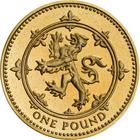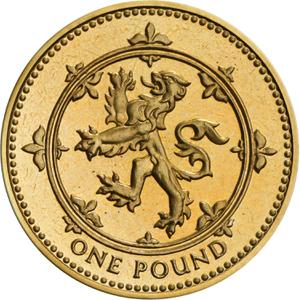By 1980 it had become apparent that with the general decline in purchasing power, the £1 unit of currency was more appropriate to a coin than a banknote. After consultation with many groups including retailers and special interest groups, the Government announced on 31 July 1981 that a new £1 coin that was to be issued on 21 April 1983. Since its launch the £1 has always represented the United Kingdom and its constituent parts: England, Wales, Scotland and Northern Ireland.
The £1 coin in base metal (as opposed to the gold sovereign, which has a nominal face value of one pound too), nickel-brass was introduced in 1983, as a replacement for the £1 banknote. The reverse design of the first £1 coin showed a depiction of the Royal Coat of Arms, representing the United Kingdom as a whole. It was issued until 2015 in rotation with other designs representing Scotland, Wales, Northern Ireland and England, alternating each year in that order.
Initially, Scotland was represented by the Thistle and Diadem type of one pound coins.
According to the Royal Mint, "The 1994 £1 coin began a new series of four which would again represent the four constituent parts of the United Kingdom. The reverse design was modelled by Norman Sillman from a drawing by the College of Arms. The obverse is graced with Raphael Maklouf's timeless portrait of Her Majesty The Queen. The Latin motto of Scotland's most noble Order of the Thistle, NEMO ME IMPUNE LACESSIT (no-one provokes me with impunity), forms the edge inscription." This design was issued only twice, in 1994 and 1999. Scotland was later represented by the 2014 One Pound with the floral emblem of Scotland.
The design was re-issued in 2008 as a collector coin (in silver and gold) as part of a 14-coin commemorative set marking the 25th Anniversary of the £1 coin.
The coin is made of Nickel-Brass, with composition of 70% copper, 5.5% nickel and 24.5% zinc.
These coins circulated until 2017, when they were demonetised and replaced with the current bimetallic one pound coin. | 



